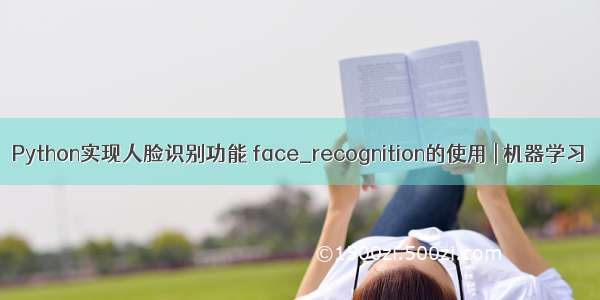
object detection是Tensorflow很常用的api,功能强大,很有想象空间,人脸识别,花草识别,物品识别等。下面是我做实验的全过程,使用自己收集的胡歌图片,实现人脸识别,找出胡歌。
安装tensorflow
官方的教程已经写得非常好了,这里就不多说,但是有一点必须注意的是,必须安装python3.6版本,不能安装最新的python3.7版本,不然会出现很多不兼容的问题难以处理。尽可能选择一台显卡性能较好的电脑做机器学习,尽量选择gpu训练,不然训练过程非常的慢。
/install/pip
安装object detection api
收集图片
我这里保存了一份胡歌的照片,一共50张,而且已经标记号了,但是我建议我们开发者应该自己动手来标记一份,尽可能的多些图片,越多越好。
/s/13Ln1FinjxX9ANkopBM6kLQ
安装标记工具labelImg
labelImg必须运行在python3.6,不然无法运行起来,这里就不展开了。
/tzutalin/labelImg
brew install qt
brew install libxml2
make qt5py3
python3 labelImg.py
标记图片
打开了标记工具,选择Open Dir把图片添加进来,然后点击Create RectBox勾选我们要选择的目标,输入对应的label,然后ctrl s保存。最终xml文件是和文件名称保存在同一目录。
image.png
把xml转换成csv格式
#!/usr/bin/env python
# -*- coding:utf-8 -*-
# xml2csv.py
import glob
import pandas as pd
import xml.etree.ElementTree as ET
path = 'data/images/train'
def xml_to_csv(path):
xml_list = []
for xml_file in glob.glob(path + '/*.xml'):
tree = ET.parse(xml_file)
root = tree.getroot()
for member in root.findall('object'):
value = (root.find('filename').text,
int(root.find('size')[0].text),
int(root.find('size')[1].text),
member[0].text,
int(member[4][0].text),
int(member[4][1].text),
int(member[4][2].text),
int(member[4][3].text)
)
xml_list.append(value)
column_name = ['filename', 'width', 'height', 'class', 'xmin', 'ymin', 'xmax', 'ymax']
xml_df = pd.DataFrame(xml_list, columns=column_name)
return xml_df
def main():
image_path = path
xml_df = xml_to_csv(image_path)
xml_df.to_csv(path + '/train.csv', index=None)
print('Successfully converted xml to csv.')
main()
把图片和csv转换成tfrecord格式
记得要修改部分地方
#!/usr/bin/env python
# -*- coding:utf-8 -*-
# generate_tfrecord.py
# -*- coding: utf-8 -*-
"""
Usage:
# From tensorflow/models/
# Create train data:
python generate_tfrecord.py --csv_input=data/tv_vehicle_labels.csv --output_path=train.record
# Create test data:
python generate_tfrecord.py --csv_input=data/test_labels.csv --output_path=test.record
"""
import os
import io
import pandas as pd
import tensorflow as tf
import cv2
from PIL import Image
from object_detection.utils import dataset_util
from collections import namedtuple, OrderedDict
os.chdir('data')
flags = tf.app.flags
flags.DEFINE_string('csv_input', 'images/train/train.csv', 'Path to the CSV input')
flags.DEFINE_string('output_path', 'images/train.record', 'Path to output TFRecord')
FLAGS = flags.FLAGS
# TO-DO replace this with label map
def class_text_to_int(row_label):
if row_label == 'huge': # 需改动
return 1
else:
None
def split(df, group):
data = namedtuple('data', ['filename', 'object'])
gb = df.groupby(group)
return [data(filename, gb.get_group(x)) for filename, x in zip(gb.groups.keys(), gb.groups)]
def create_tf_example(group, path):
with tf.gfile.GFile(os.path.join(path, '{}'.format(group.filename)), 'rb') as fid:
encoded_jpg = fid.read()
encoded_jpg_io = io.BytesIO(encoded_jpg)
image = Image.open(encoded_jpg_io)
width, height = image.size
filename = group.filename.encode('utf8')
image_format = b'jpg'
xmins = []
xmaxs = []
ymins = []
ymaxs = []
classes_text = []
classes = []
for index, row in group.object.iterrows():
xmins.append(row['xmin'] / width)
xmaxs.append(row['xmax'] / width)
ymins.append(row['ymin'] / height)
ymaxs.append(row['ymax'] / height)
classes_text.append(row['class'].encode('utf8'))
classes.append(class_text_to_int(row['class']))
tf_example = tf.train.Example(features=tf.train.Features(feature={
'image/height': dataset_util.int64_feature(height),
'image/width': dataset_util.int64_feature(width),
'image/filename': dataset_util.bytes_feature(filename),
'image/source_id': dataset_util.bytes_feature(filename),
'image/encoded': dataset_util.bytes_feature(encoded_jpg),
'image/format': dataset_util.bytes_feature(image_format),
'image/object/bbox/xmin': dataset_util.float_list_feature(xmins),
'image/object/bbox/xmax': dataset_util.float_list_feature(xmaxs),
'image/object/bbox/ymin': dataset_util.float_list_feature(ymins),
'image/object/bbox/ymax': dataset_util.float_list_feature(ymaxs),
'image/object/class/text': dataset_util.bytes_list_feature(classes_text),
'image/object/class/label': dataset_util.int64_list_feature(classes),
}))
return tf_example
def main(_):
writer = tf.python_io.TFRecordWriter(FLAGS.output_path)
path = os.path.join(os.getcwd(), 'images/train') # 需改动
examples = pd.read_csv(FLAGS.csv_input)
grouped = split(examples, 'filename')
for group in grouped:
tf_example = create_tf_example(group, path)
writer.write(tf_example.SerializeToString())
writer.close()
output_path = os.path.join(os.getcwd(), FLAGS.output_path)
print('Successfully created the TFRecords: {}'.format(output_path))
if __name__ == '__main__':
tf.app.run()
创建.pbtxt文件
在object_detection/data创建一个train.pbtxt文件,和上面生成tfrecord的改动是对应的。
item {
id: 1
name: 'huge'
}
复制修改ssd_mobilenet_v1_coco.config
research/object_detection/samples/configs/ssd_mobilenet_v1_coco.config
在上面的目录可以找到ssd_mobilenet_v1_coco.config配置文件,复制出来放到object_detection/data目录,然后把文件里面带有PATH_TO_BE_CONFIGURED的地方都修改成我们对应的文件路径。
image.png
最终的文件目录结构
创建文件夹data/training,最后文件结构如下
data
├── images
│ ├── train
│ │ ├── 1.jpg
│ │ ├── 1.xml
│ │ ├── 2.jpg
│ │ ├── 2.xml
│ │ ├── ...
│ │ ├── train.csv
│ ├── training
├── train.record
├── train.pbtxt
└── ssd_mobilenet_v1_coco.config
开始训练
cd research/object_detection
python3 model_main.py \
--pipeline_config_path=data/ssd_mobilenet_v1_coco.config \
--model_dir=data/training \
--num_train_steps=60000 \
--num_eval_steps=20 \
--alsologtostderr
启动训练之后,research/object_detection/data/training文件夹就会陆陆续续创建了一些文件。
loss需要低于1.0才可以达到很好的效果,训练过程非常的漫长,这个和电脑的性能有很大关系,我训练了二十多小时才训练了30000多次step,效果才让loss降低到1.0以下,有条件就使用gpu进行训练,记得使用nohup命令后台训练。
监测训练tensorboard
tensorboard --logdir=object_detection/data/training
在浏览器输入地址查看:http://localhost:6006,从右边的图表可以看到训练的loss的值
image.png
监测训练效果
左边的预测的效果,右边是我们设定的正确效果,一定要有耐心,我也曾经一度怀疑是不是我代码写错了,跑了二十几个小时才看到预测正确。
image.png
生成.pb模型文件
下面是训练生成的目录结构
image.png
需要把下面命令的28189改成training文件夹训练的最后数字
cd research/object_detection
python3 export_inference_graph.py \
--input_type=image_tensor \
--pipeline_config_path=data/ssd_mobilenet_v1_coco.config \
--trained_checkpoint_prefix=data/training/model.ckpt-28189 \
--output_directory=data/training
等命令执行完毕后,就可以看到生成了我们要的frozen_inference_graph.pb文件。
测试模型
在data/test_images增加三张胡歌的图片image1.jpg、image2.jpg、image3.jpg,执行下面代码
(在research/object_detection/object_detection_tutorial.ipynb可以看到这些代码)
# object_detection_tutorial.py
import os
from distutils.version import StrictVersion
import numpy as np
import tensorflow as tf
from PIL import Image
import cv2
from object_detection.utils import ops as utils_ops
if StrictVersion(tf.__version__) < StrictVersion('1.9.0'):
raise ImportError('Please upgrade your TensorFlow installation to v1.9.* or later!')
from object_detection.utils import label_map_util
from object_detection.utils import visualization_utils as vis_util
MODEL_NAME = 'data/'
PATH_TO_FROZEN_GRAPH = MODEL_NAME + 'training/frozen_inference_graph.pb'
PATH_TO_LABELS = MODEL_NAME + "train.pbtxt"
detection_graph = tf.Graph()
with detection_graph.as_default():
od_graph_def = tf.GraphDef()
with tf.gfile.GFile(PATH_TO_FROZEN_GRAPH, 'rb') as fid:
serialized_graph = fid.read()
od_graph_def.ParseFromString(serialized_graph)
tf.import_graph_def(od_graph_def, name='')
category_index = label_map_util.create_category_index_from_labelmap(PATH_TO_LABELS, use_display_name=True)
def load_image_into_numpy_array(image):
(im_width, im_height) = image.size
return np.array(image.getdata()).reshape(
(im_height, im_width, 3)).astype(np.uint8)
PATH_TO_TEST_IMAGES_DIR = MODEL_NAME + '/test_images'
TEST_IMAGE_PATHS = [os.path.join(PATH_TO_TEST_IMAGES_DIR, 'image{}.jpg'.format(i)) for i in range(1, 4)]
IMAGE_SIZE = (12, 8)
def run_inference_for_single_image(image, graph):
with graph.as_default():
with tf.Session() as sess:
# Get handles to input and output tensors
ops = tf.get_default_graph().get_operations()
all_tensor_names = {output.name for op in ops for output in op.outputs}
tensor_dict = {}
for key in [
'num_detections', 'detection_boxes', 'detection_scores',
'detection_classes', 'detection_masks'
]:
tensor_name = key + ':0'
if tensor_name in all_tensor_names:
tensor_dict[key] = tf.get_default_graph().get_tensor_by_name(
tensor_name)
if 'detection_masks' in tensor_dict:
# The following processing is only for single image
detection_boxes = tf.squeeze(tensor_dict['detection_boxes'], [0])
detection_masks = tf.squeeze(tensor_dict['detection_masks'], [0])
# Reframe is required to translate mask from box coordinates to image coordinates and fit the image size.
real_num_detection = tf.cast(tensor_dict['num_detections'][0], tf.int32)
detection_boxes = tf.slice(detection_boxes, [0, 0], [real_num_detection, -1])
detection_masks = tf.slice(detection_masks, [0, 0, 0], [real_num_detection, -1, -1])
detection_masks_reframed = utils_ops.reframe_box_masks_to_image_masks(
detection_masks, detection_boxes, image.shape[0], image.shape[1])
detection_masks_reframed = tf.cast(
tf.greater(detection_masks_reframed, 0.5), tf.uint8)
# Follow the convention by adding back the batch dimension
tensor_dict['detection_masks'] = tf.expand_dims(
detection_masks_reframed, 0)
image_tensor = tf.get_default_graph().get_tensor_by_name('image_tensor:0')
# Run inference
output_dict = sess.run(tensor_dict,
feed_dict={image_tensor: np.expand_dims(image, 0)})
# all outputs are float32 numpy arrays, so convert types as appropriate
output_dict['num_detections'] = int(output_dict['num_detections'][0])
output_dict['detection_classes'] = output_dict[
'detection_classes'][0].astype(np.uint8)
output_dict['detection_boxes'] = output_dict['detection_boxes'][0]
output_dict['detection_scores'] = output_dict['detection_scores'][0]
if 'detection_masks' in output_dict:
output_dict['detection_masks'] = output_dict['detection_masks'][0]
return output_dict
for image_path in TEST_IMAGE_PATHS:
print(image_path)
image = Image.open(image_path)
image_np = load_image_into_numpy_array(image)
image_np_expanded = np.expand_dims(image_np, axis=0)
output_dict = run_inference_for_single_image(image_np, detection_graph)
vis_util.visualize_boxes_and_labels_on_image_array(
image_np,
output_dict['detection_boxes'],
output_dict['detection_classes'],
output_dict['detection_scores'],
category_index,
instance_masks=output_dict.get('detection_masks'),
use_normalized_coordinates=True,
line_thickness=8)
image = Image.fromarray(image_np.astype('uint8')).convert('RGB')
image.show()
cv2.waitKey(0)
那么就可以看到执行的结果了
image.png
总结
这次探索了几天的时候,一开始是没有安装object detection,想直接在源码上运行,但是这是行不通的,必须安装,这是我遇到的第一个坑。然后就是标记图片的时候部分图片标签错了,导致运行了十几个小时都毫无进展,标记图片必须好好检查一遍。由于我是用mac电脑,无法使用gpu训练,特别的慢,一旦训练起来,我的电脑就不能做其他事情,运行了十几个小时没有结果就一点,一度以为是我训练不对,就没有耐心停掉了。后来弄了一台Linux电脑,但是没有显卡,通过在后台训练了二十几个小时终于看到了成功,后续我会在Android和iOS运用我们这次的训练成功,敬请关注。


![[Python人工智能] 十.Tensorflow+Opencv实现CNN自定义图像分类案例及与机器学习KNN图](https://1500zi.500zi.com/uploadfile/img/14/837/656f8b6d9e5d18424dd1de3552bcec5c.jpg)











